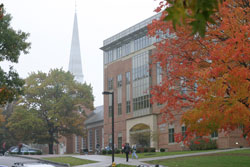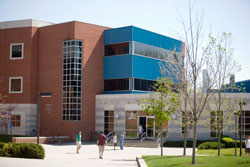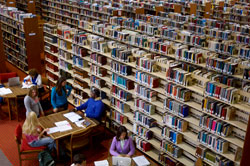Boyer Hall

Boyer Hall |
Completed in 2003, Boyer Hall is newest academic building on campus. The structure houses both the School of the Humanities and the School of Education and Social Sciences and was built with funds raised during the College’s largest fund-raising campaign—To Serve and To Lead.
The building contains 22 general use classrooms, a 129-seat movie theatre (Parmer Cinema), a film studio, specialized classrooms for teacher education; a language laboratory, department resource rooms, and offices for 45% of the College’s faculty.
The building is named for Ernest L. Boyer, a 1948 alumnus, who held several prominent positions, including chancellor of the State University of New York; Commissioner of Education under President Jimmy Carter, and president of the Carnegie Foundation for Advancement of Teaching. The facility was constructed to continue Boyer’s legacy of cultivating innovative educational practice and scholarship from early childhood through higher education.
Climenhaga Fine Arts Center
The Climenhaga Fine Arts Center was built in 1981 on the site where S. R. Smith’s home was originally built when the campus relocated to Grantham. The Climenhaga Fine Arts Center created expanded facilities for the School of the Arts, including music, visual arts, and theatre.
The building is named for Asa and Anna (Kipe) `16 Climenhaga. He was the first academic dean of the College and also taught painting; she taught Latin. They also donated a large portion of their farmland to the College.
The Climenhaga Fine Arts Center houses Miller Auditorium, named in honor of Earl “Prof” Miller, a standout student at Messiah who was asked to conduct the boys’ and girls’ glee club in 1926 and then spent many years leading and directing music ensembles at Messiah. The Aughinbaugh Art Gallery, located in the basement of the Center, is named for M. Louise Aughinbaugh, and Poorman Recital Hall, a popular rehearsal and performance space, is named for Mr. and Mrs. D. S. Poorman.
The Climenhaga Fine Arts Center also includes practice rooms, art studios, classrooms, and faculty offices.
Frey Hall

Frey Hall |
Frey Hall is home to state-of-the-art labs and classrooms for the School of Mathematics, Engineering, and Business as well as art studios for the School of the Arts. The building also houses several large lecture halls, 50 faculty offices, and many classrooms. Frey Hall was completed in 1991 and is easily recognized by its bright blue exterior.
Frey Hall is named in honor of the Armor and Mary Frey family, founders of Turkey Hill Dairy in 1931. More than 20 descendents of Armor and Mary Frey have attended Messiah College, and Turkey Hill has remained a longstanding supporter of the College and its mission.
Jordan Science Center
The Jordan Science Center, constructed in 1999, houses the Department of Health and Natural Sciences and the Oakes Museum. The building is named in honor of Richard E. Jordan Sr. and his family. The Jordans have faithfully supported the College through the years.
The Oakes Museum features more than 40,000 Smithsonian-quality artifacts from Africa and North America. The Museum is named in honor of Galen and Boots Oakes, both Messiah College alumni and supporters of the school for six decades. The Museum brings many elementary school children, Boy and Girl Scout troops, and local residents to the campus.
Kline Hall of Science
When the Kline Hall of Science was built in 1969, it was really one of the first academic buildings on campus outside of Old Main. At the time, the College was in desperate need of additional academic space to keep pace with its growing enrollment. The Kline Hall of Science provided lab space, as well as classroom and faculty offices.
The building is named in honor of Josiah and Bessie Kline. Josiah was one day being chauffeured through campus when he spied students and faculty beautifying the campus. He was so impressed that he immediately made a donation to the College, the largest one they had received to that date.
Kline Hall now serves as home to the nursing department, various other science labs, and a greenhouse.
Murray Library

Murray Library |
The College’s first library was housed in Old Main and consisted only of a few donated volumes. In 1957, the library moved to what is now the left wing of the present-day library. In 1977, a large addition was constructed that expanded the library’s space to 58,000 square feet. Students and faculty were given a day off classes to help transport books from the old space to the new space.
Construction of the new addition to the library proved challenging: builders bringing in materials were unable to make the sharp turn on Mill Road to get supplies to the site so many of the beams were delivered via crane.
The library is named for William Lynch Murray, the architect who designed the building. Murray strongly identified with the College and its mission.
Now, the Murray Library houses more than 300,000 paper volumes. The Brethren in Christ Church Archives and Messiah College Archives are located in the basement as well as an audio/video production studio.
|










